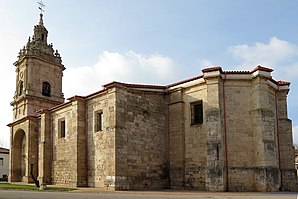Cubo de Bureba (Burgos)
| Cubo de Bureba municipality | ||
|---|---|---|
 Cubo de Bureba - Church of San Millán Abad
|
||
| coat of arms | Map of Spain | |

|
|
|
| Basic data | ||
| Autonomous Community : |
|
|
| Province : | Burgos | |
| Comarca : | La Bureba | |
| Coordinates | 42 ° 38 ′ N , 3 ° 12 ′ W | |
| Height : | 685 msnm | |
| Area : | 9.8 km² | |
| Residents : | 98 (Jan. 1, 2019) | |
| Population density : | 10 inhabitants / km² | |
| Postal code : | 09280 | |
| Municipality number ( INE ): | 09115 | |
| administration | ||
| Website : | Cubo de Bureba | |
Cubo de Bureba is a northern Spanish town and a rural municipality ( municipio ) with only 98 inhabitants (as of January 1, 2019) in the province of Burgos in the autonomous community of Castile-León .
Location and climate
The place Cubo de Bureba is located at a height of approx. 685 m on the "Corridor of La Bureba ", a connection between the upper Ebro Valley and the landscapes north of the Duero, which was already used in the Stone Age . The provincial capital Burgos is a good 57 km (driving distance) to the southwest; the next largest city, Miranda de Ebro , is about 26 km northeast. The climate in winter is harsh, but in summer it is temperate and warm; The rain, which is abundant by Spanish standards (approx. 720 mm / year) falls - with the exception of the summer months - over the year.
Population development
| year | 1857 | 1900 | 1950 | 2000 | 2017 |
| Residents | 764 | 512 | 491 | 113 | 101 |
The mechanization of agriculture and the closure of smaller farms have led to a loss of jobs and thus to a migration of people to the larger cities ( rural exodus ) since the middle of the 20th century .
economy
For centuries, the inhabitants of the community lived mainly from agriculture (agriculture, viticulture and small livestock farming) as a self-sufficient living ; only since the middle of the 20th century has it been produced for the national market. Tourism in the form of rental of holiday homes (casas rurales) has also played a certain role in the municipality's income since the 1960s.
history
The surroundings of the place were already known to the people of the Stone Age and Antiquity as a widely used connection route; Celts from the tribe of the Autrigones settled here and the Romans called their later settlement Tritium Autrigonum . In the 8th and early 9th centuries, the area was under Islamic influence, but the area was neither permanently settled nor defended by the Berbers due to the unusually harsh and rainy climate . At the end of the 9th century, the Castilian Count Diego Rodríguez Porcelos received from King Alfons III. of Asturias the order to repopulate ( repoblación ) the depopulated area. The first mention of the place name Cupo comes from the year 1065.
Attractions
- The three-aisled Iglesia de San Millán Abad dates from the 18th century. While the actual church building with its buttresses still looks Gothic, the rectangular windows leave no doubt as to its baroque origins. Particularly noteworthy is the upper floor of the likewise baroque bell tower (campanario) with its ribbed dome surrounded by a balustrade with a lantern at the end . The portal, which is rather reserved compared to the tower, shows a figure of St. Aemilianus of Cogolla . Inside, the choir stalls (sillería) and the old organ are impressive .
- In the village square there is a fountain from 1902 with a Castilian-Leonese coat of arms.
Web links
Individual evidence
- ↑ Cifras oficiales de población resultantes de la revisión del Padrón municipal a 1 de enero . Population statistics from the Instituto Nacional de Estadística (population update).
- ↑ Cubo de Bureba - climate tables
- ↑ Cubo de Bureba - population development
- ↑ Cubo de Bureba - History
